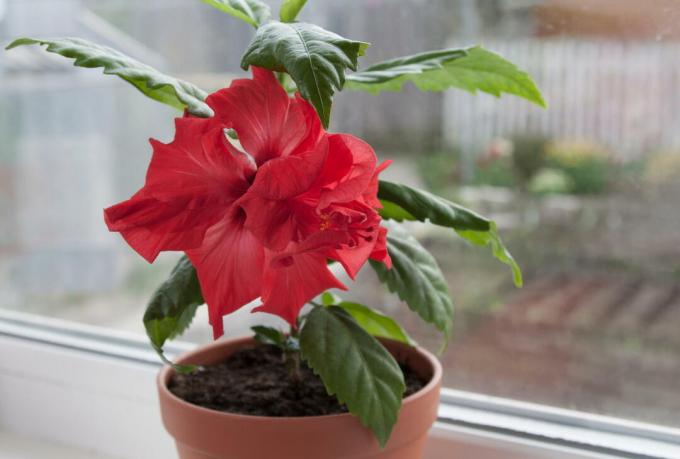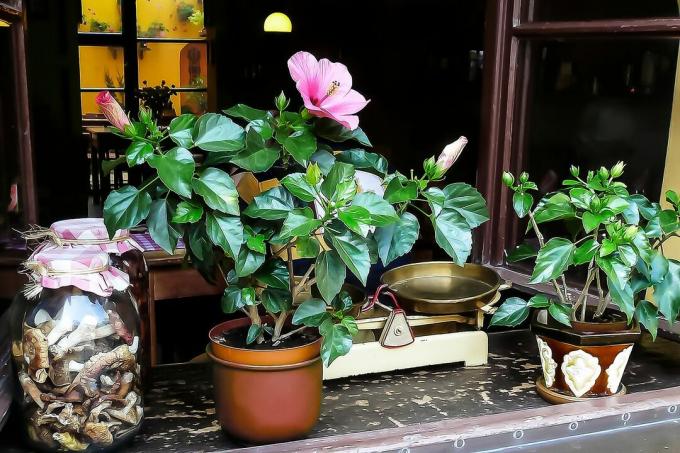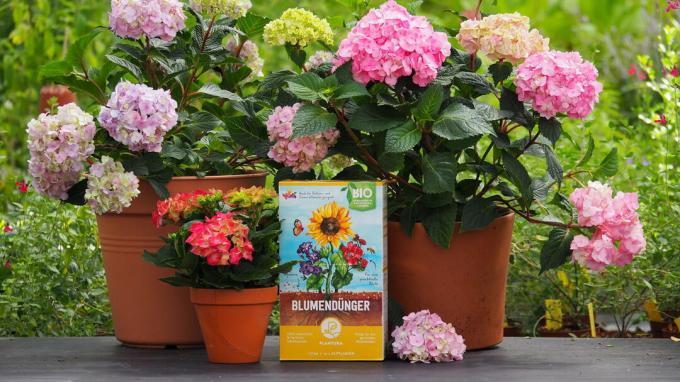Many only know hibiscus as sprawling bushes and hedges. We present a few smaller varieties that can also be planted in pots.

Some don't want to see you in the apartment or on the balcony hibiscus (Hibiscus) waive. They don't have to, because hibiscus can also be planted in pots. Of course, there are a few differences to growing outdoors. However, as soon as you know these, nothing stands in the way of growing hibiscus in a pot. In our article we will tell you everything about suitable species and varieties, how to plant hibiscus in a pot and what you need to consider when caring for them.
contents
- Hibiscus varieties for the pot
-
Plant hibiscus in a pot
- Hibiscus in a pot: location
- Hibiscus in a pot: The right substrate
-
Caring for hibiscus in the pot
- Water the hibiscus in the pot
- Cut the hibiscus in the pot
- Fertilize hibiscus in the pot
- Repot hibiscus
- Overwinter the hibiscus in a pot
Hibiscus varieties for the pot
Above all, hibiscus varieties for growing in pots should be small. The frost resistance does not play a role here, since the plants spend the winter indoors. The rose hibiscus (
Hibiscus rosa-sinensis), also called Chinese hibiscus. This type of hibiscus is also called indoor hibiscus - it is therefore ideal for growing as a houseplant, on the terrace or on the balcony. The type of rose hibiscus includes an incredible number of and sometimes rare varieties. None of them are hardy. We will now introduce you to some varieties that have proven to be particularly suitable for cultivation in pots.
- 'standing ovation': This variety convinces with red-orange and yellow, very large flowers. The plant can grow up to 15 centimeters high.
- 'Tahitian Flaming Dragon': This variety has pink flowers with white stripes. The plant can grow up to 30 centimeters high and flowers from April to November.
- 'Dark Continent': This variety impresses with flowers that are brown on the outside and ruby red on the inside and have a diameter of up to 18 centimetres. The plant itself can grow up to 30 centimeters high and flowers from April to November.
- 'Jolanda Gommer': The flowers of this variety are purple, red and orange. The plant rarely grows very tall, a maximum of 30 centimetres.
- 'Voodoo Magic': This hibiscus variety owes its name to its very special flowers. These are dark brown and have an orange eye in the middle. Flowering time is from April to November.
Even more Hibiscus Varieties can be found here in our special article.
Plant hibiscus in a pot
Before the hibiscus can be planted in a pot, it is important to find the right location for it. In summer, the pot hibiscus can be in the room as well as outside on the balcony, the terrace or directly in the garden. The hibiscus likes it sunny and warm - both outside and inside. In the room, it is best to place it on the window sill. However, the hibiscus does not like the blazing midday sun, so the curtain in front of the window should be drawn at noon or a place outside of it should be chosen. A place above the heater does not bother the hibiscus as long as it is sufficiently supplied with water and humidity. That's why regular watering and moistening in the room is very important, you can find out more about this below.

Hibiscus in a pot: location
At temperatures between 18 and 28 °C in the room, the hibiscus feels most comfortable in a pot. If the temperatures outside are consistently above 15°C, your indoor hibiscus can move outside in the summer. Here it prefers a semi-shady and sheltered location. Both indoors and outdoors: the hibiscus is extremely site-loyal. This means that once it starts blooming, it shouldn't be moved. A change of location means a lot of stress for the plant and can lead to the flowers being dropped. If the temperatures fall below 15 °C in autumn, the hibiscus has to move to its winter quarters.
Summary of potted hibiscus location:
- In the room: Sunny, but not blazing midday sun
- Optimum temperature range indoors between 18 and 25 °C
- Only place outdoors when the temperature is constantly above 15 °C
- Outside: Semi-shady and sheltered location
- Bring in in autumn when temperatures drop below 15°C
- Once flowers are set, do not change location

Hibiscus in a pot: The right substrate
Your hibiscus thrives best in a pot in humus-rich and nutrient-rich soil. It is also important that this is very permeable and excess water can drain off easily. If the substrate is very compact, it can therefore make sense to loosen it up with sand. You should create a drainage system in the pot so that the water can run off easily. Otherwise waterlogging can lead to root rot on the hibiscus. Therefore, make sure that the pot has a drainage hole.
Summary of potted hibiscus substrate:
- rich in humus
- nutritious
- permeable
- With drainage
Below we have summarized all the important points for planting hibiscus in pots:
- Choose a sufficiently large pot
- create a drainage layer
- Fill the pot 1/3 full with substrate
- Put in the hibiscus plant
- Fill the pot with substrate
- Pour generously
More tips about Planting and Propagating Hibiscus you'll find here.
Caring for hibiscus in the pot
Only an optimally cared for hibiscus will reward you with a lush bloom. We will therefore tell you what is important when watering, fertilizing, cutting and repotting hibiscus in a pot.

General tips for Care of hibiscus you can read here.
Water the hibiscus in the pot
The hibiscus is a thirsty roommate. The high water requirement therefore requires regular watering of the potted plant. The substrate should never dry out completely, so you have to water it more, especially in summer. However, this requires a bit of finesse. With the thumb test - simply press your thumb a few centimeters into the substrate - you can determine the moisture content of the soil. If this feels dry, you need to water. The entire substrate should be penetrated by water. However, no waterlogging should occur. If the hibiscus is in the room on the window sill directly above the heating, it is also happy to be sprayed with water regularly.
Summary watering potted hibiscus:
- Water more in summer
- Water regularly and thoroughly
- No waterlogging
- No ball dryness
Cut the hibiscus in the pot
So that your hibiscus does not get too big in the pot and remains small and compact, you should cut it back annually. Since the hibiscus forms its flowers on annual shoots, spring is the ideal time for pruning. Then cut back your hibiscus by 15 centimeters. The harder the hibiscus is cut back, the denser the plant will be. You can also remove all dried shoots, leaves and flowers.
A detailed guide to Cutting hibiscus you'll find here.
Fertilize hibiscus in the pot
In order to have enough energy for the lush and large flowers, the hibiscus needs sufficient and regular fertilizer. In the pot, you should provide your hibiscus with nutrients once a week during the growth phase from March to October.

For example, our is suitable for this Plantura organic flower fertilizer. This consists primarily of organic substances and supplies your hibiscus gently with sufficient nutrients over the long term. In winter, the hibiscus in the pot is not fertilized.
More information about Fertilizing hibiscus can be found in our special article.
Repot hibiscus
Proper care for your hibiscus also includes regular repotting. The hibiscus should be repotted in the third year after purchase - at the latest, however, as soon as the entire pot has been penetrated by the roots of the plant. After the first repotting, the pots are changed every two years. For the new vessel, choose a pot that is only a few inches larger than the old one. The best time for repotting is spring. Then proceed as follows to repot:
- Carefully remove the hibiscus from the old pot
- Loosen the root ball well
- Shorten long, overhanging roots with scissors
- Use new potting soil

Overwinter the hibiscus in a pot
The rose hibiscus is not hardy and therefore has to spend the cold time indoors. During the hibernation, the hibiscus should be in a cool but bright place. The optimal room temperature for wintering is between 12 and 15 °C. Temperatures should never fall below 12 °C, otherwise the hibiscus may shed all of its leaves. If your hibiscus loses a few leaves in winter, you don't have to turn on the heating immediately. A little loss of leaves in winter is quite normal. Temperatures above 20°C are now more likely to damage your hibiscus. Even in winter, the hibiscus must be watered regularly. The substrate should never dry out, but you have to water significantly less in winter than in summer. Fertilizers are not necessary during the dormant phase in winter.
The most important things about overwintering hibiscus at a glance:
- Bright location
- Temperatures between 12 and 15 °C
- Water little but regularly
- Don't fertilize
Even more information about the right one Overwintering Hibiscus you'll find here.
